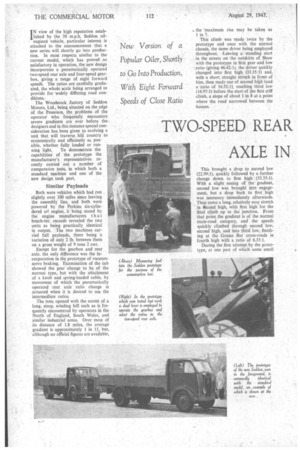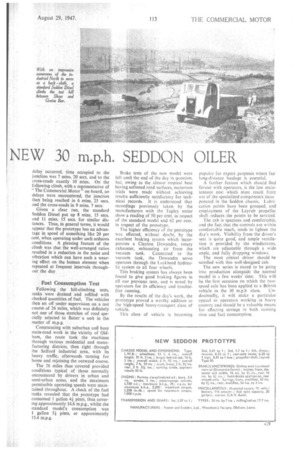TWO-SPEED REAR NEW 30 p.h. SEDDON OILER
Page 30

Page 31

If you've noticed an error in this article please click here to report it so we can fix it.
IN view of the high reputation established by the 30 m.p.h. Seddon oilengined vehicle, particular interest is attached to the announcement that a new series will shortly go into production. In most respects similar to the current model, which has proved so satisfactory in operation, the new design incorporates a pneumatically operated two-speed rear axle and four-speed gearbox, giving a range of eight forward speeds. The ratios are carefully graduated, the whole scale being arranged to provide for widely differing road conditions.
The Woodstock factory of Seddon Motors, Ltd., being situated on the edge of the Pennines, the problems of the operator who frequently encounters severe gradients are ever before the designers and in this instance special consideration has been given to evolving a unit that will traverse hill country as economically and efficiently as possible, whether fully loaded or run ning light. To demonstrate the capabilities of the prototype the manufacturer's representatives recently carried out a number of comparative tests, in which both a standard machine and one of the new design took part.
Similar Payloads
Both were vehicles which had run slightly, over 100 miles since leaving the assembly line, and both were powered by the Perkins six-cylindered oil engine, it being stated by the engine manufacturers that bench-test records revealed the two units as being practically identical in output. The two machines carried full payloads, there being a variation of only 2 lb. between them on a gross weight of 9 tons 2 cwt.
Except for the gearbox and rear axle, the only difference was the incorporation in the prototype of vacuumservo braking. Examination of the cab showed the gear change to be of the normal type, but with the attachment of a knob and spring-loaded cable, by movement of which the pneumatically operated rear axle ratio change is actuated when it is desired to use the intermediate ratios.
The tests opened with the ascent of a long, steep, winding hill such as is frequently encountered by operators in the North of England, South Wales, and similar industrial areas. Over most of its distance of 1.8 miles, the average gradient is approximately 1 in 11, but, although no official figures are available, the 'maximum rise may be taken as 1 in 7.
This climb was made twice by the prototype and once with the normal chassis, the same driver being employed throughout. Leaving a standing start in the streets on the outskirts of Shaw with the prototype in first gear and low ratio (giving 46.411), the driver quickly changed into first high (33.35:1) and, with a short, straight stretch in front of him, then math use of second high (and a ratio of 16.52:1), reaching third low (14.97:1) before the start of the first stiff climb, a slope of about 1 in 8 at a point where the road narrowed between the houses.
-1 .• AXLE IN This brought a drop to second low (22.99:1), quickly followed by a further change down to first high (33.35:1). With a slight easing of the gradient, second low was brought into engagement, but a drop back to first high was necessary immediately afterwards. Then came a long, relatively easy stretch in tecond high, with first high for the final climb up to the junction. From that point the gradient is of the normal main-road category, and the speeds quickly climbed through second low, second high, and into third low, finishing at the Grains Bar cross-roads in fourth high with a ratio of 6.33:1.
During the first attempt by the prototype, at one part of which some small
delay occurred, time occupied to the junction was 7 mins. 20 secs, and to the cross-roads exactly 10 mins, On the following climb, with a representative of "The Commercial Motor" on board, no delays were encountered, the junction then being reached in 6 mins. 25 secs. and the cross-roads in 9 mins. 7 secs.
Given a clear run, the standard Seddon Diesel put up 8 mins. 15 secs. and 11 mins. 15 secs. for similar distances. Thus, in general terms, it would appear that the prototype has an advantage in speed of something like 20 per cent, when operating under such arduous conditions. A pleasing feature of the climb was that the well-arranged ratios resulted in a reduction in the noise and vibration which can have such a wearing effect on the human element when repeated at frequent intervals throughout the day.
Fuel Consumption Test
Following the hill-climbing tests, tanks were drained and refilled with checked quantities of fuel. The vehicles then set off under supervision on a test course of 26 miles, which was definitely not one of those stretches of road specially selected to flatter a unit in the matter of m.p.g.
• Commencing with suburban anti busy main-road work in the vicinity of Oldham, the route took the machines through various residential and manufacturing districts, then right through the Salford industrial area, with its heavy traffic, afterwards turning for home and rejoining the outward course.
The 26 miles thus covered provided conditions typical of those normally encountered by drivers in urban and semi-urban areas, and thefl maximum permissible operating speeds were maintained throughout. A check of the fuel tanks revealed that the prototype had consumed 1 gallon 41 pints, thus covering approximately 16.6 m.p.g., whilst the standard model's consumption was 1 gallon 5i pints, or approximately 15.4 m.p.g.
Brake tests of the new model were left until the end of the day in question, but, owing to the almost tropical heat having softened road surfaces, numerous trials were made without achieving results sufficiently satisfactory for technical records. It is understood that recordings previously taken by the manufacturers with the Tapley meter show a reading of 50 per cent, in respect of the standard model and 62 per cent. in respect of the prototype.
The higher efficiency of the prototype was effected, without doubt, by the excellent braking system which incorporates a Clayton Dewandre, rotary exhauster, exhausting air from the vacuum tank. Connected to the vacuum tank, the Dewandre servo operates through the Lockheed hydraulic system to all four wheels.
This braking system has always been found to give good braking figures in all our previous tests, and is noted by operators for its efficiency and troublefree running.
By the results of the day's work, the prototype proved a worthy addition to the high-speed heavy-transport class of vehicle.
• ('his class of vehicle is becoming
popular for export purposes where fas, long-distance haulage is essential.
A further feature which should find favour with operators, is the low maintenance cost which must result from use of the specialized components incor porated in the Seddon chassis. Lubrication points have been grouped, and employment of the Layrub propeller shaft reduces the points to be serviced.
The cab is spacious and comfortable, and the fact that the controls are within comfortable reach, tends to lighten the day's work. Visibility from the driver's seat is quite good, and ample ventilation is provided by the windscreens, whiCh are adjustable through a wide angle, and fully dropping windows.
The most critical driver should he satisfied with this well-designed cab.
The new series is stated to be going into production alongside the normal model in a few weeks' time. This will be the first occasion on which the twospeed axle has been applied to a British vehicle in the 30 rn.p.h class. Undoubtedly, it will make a particular appeal to operators working in heavy country and should be a valuable means for effecting savings in both running time and fuel consumption.












































































